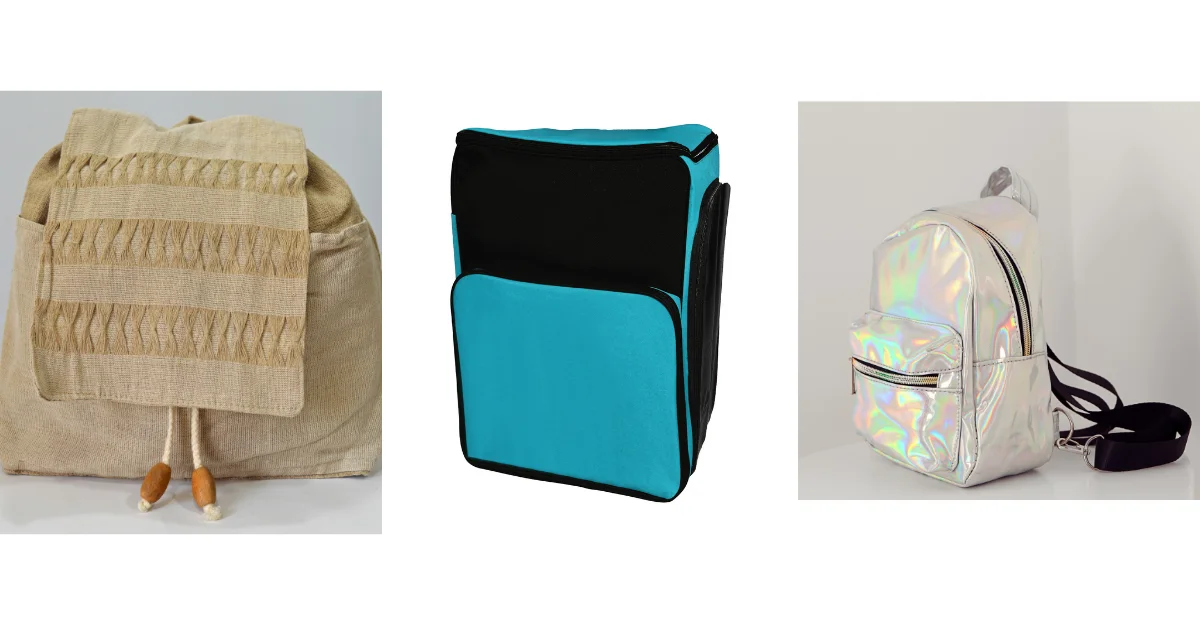Many different types of backpacks have been used in daily life, including commuter bags, school bags, laptop bags, and outdoor backpacks. The material needed for a backpack fluctuates due to the numerous purposes it may be put to.
The ideal backpack material for you can be difficult to choose because they differ in weight, sturdiness, water resistance, and other qualities.
The material affects the backpack’s durability, weight, and overall performance.
The material decides how well the backpack endures use, the weight of your stuff, and weather conditions. Let’s look at some of the materials that are frequently utilized to make backpacks.
Different types of backpack material
Nylon

Nylon is one of the most common and widely utilized fabrics in backpacks nowadays. It provides good protection against water, tearing, and abrasion.
Nylon backpacks are frequently prioritized by travelers due to their superior abrasion resistance, water resistance, high durability, and smoothness.
Nylon backpacks are also recognized for drying quickly, which makes them perfect for travel and outdoor activities.
Other Guide: 6 Ways To Attach Backpack To Luggage
Polyester
The most frequently used synthetic fiber in the world, polyester has the highest yield. It resists wrinkling and creasing naturally.
Backpacks made of polyester are thin and have good abrasion resistance. They might not be as strong as nylon, but they are still a common material for daily use and casual outings.
Additionally, because it is less static than nylon, you are less likely to experience a shock in very arid circumstances.
Canvas

Backpacks made of canvas are a relic of earlier travel times. Canvas was initially always made of cotton, which made it rather heavy.
It can now be made from a variety of fibers, some of which are lighter than others. Even though it is usually quite heavy, it is strong and lasts for a very long time.
They provide a timeless design, which is why many people who want to look vintage or retro favor them. Canvas backpacks, however, might not offer as much water resistance as nylon or polyester ones.
Other Guide: Can You Use A Backpack As Checked Luggage?
Cordura
Today, Cordura is a full-service brand with a selection of Cordura materials that serve a variety of purposes.
Oxford backpacks are less resistant to abrasion and wear than Cordura backpacks, although Cordura backpacks cost significantly more.
Hikers, mountaineers, and outdoor enthusiasts that need a backpack that can withstand demanding activities and challenging terrain frequently use Cordura backpacks.
Leather
In the past, leather was a popular material for rucksack construction. Goat, cow, and pig skins, as well as processed or dried animal skins, are examples of genuine leather.
Backpacks made of leather are considered sophisticated and elegant.
They are a well-liked option for professionals and fashion-conscious people looking for a balance between style and usefulness.
Ripstop
Ripstop The most common one is probably nylon, however the name “ripstop” only indicates that a particular type of weave is present in the fiber.
A thicker, stronger fiber is inserted at predetermined intervals throughout the regular weave.
As a result, the fabric becomes generally stronger and more wear-resistant and has the special ability to prevent minor tears from spreading further.
Oxford
Oxford is a synthetic polyamide textile consisting of nylon or polyester. The Oxford rucksack is affordable and strong enough to be used for regular everyday use.
However, if loaded excessively over time, the durability and wear resistance would decrease. Additionally, it frequently serves as a compartment or lining for a rucksack.
Denim
One type of woven cotton fiber is denim. Denim is so tough and resilient that denim backpacks can last for many years. They are fashionable at all times, nevertheless.
Polypropylene
A type of material called polypropylene is rarely used to make backpack. Although polypropylene is less frequently used in backpacks, it is still a fantastic plastic for many reasons.
They are very simple to make and reusable. Despite having a high melting point, they are combustible, which could be dangerous.
Ballistic Nylon
It’s not a distinct kind of nylon that is ballistic nylon. It is actually a fabric made using the 22-basket weave weaving method.
Ballistic Nylon was initially utilized by the military as a prototype for bulletproof fabric.
Unfortunately, it did not work as well as they had planned, and Kevlar vests and other more recent “bulletproof” choices have subsequently taken their place.
It has strong durability against abrasion and is tough. It is easily treatable to create a cloth that is practically entirely waterproof. Ballistic Nylon is a thick material, thus despite being quite robust, backpacks made with it are frequently hefty.
Kodra Nylon
Kodra, a substitute for Cordura, was created by a firm in Korea (Kolon International), which has a long history of producing nylon-based fabrics going all the way back to the 1950s.
Very comparable to Cordura, but with less strict rules or controls. Even today, Kodra textiles are regarded as being of outstanding quality.
PVC
All styles of workwear and workwear products can be made with PVC Fabric because it is strong and vibrant. Additionally, it can be used to weatherproof and give color to bags. and toughness.
PVC backpacks are a fashion icon in today’s society since they may be made in a distinctive translucent or candy-colored design that is glossy and attractive.
PVC is very lightweight and inexpensive. However, because PVC backpacks are not durable or tough, you should only carry light items inside.
Which Is the Longest-Lasting Backpack?
Generally speaking, nylon is regarded as the strongest material for backpacks. It can resist rough terrain without becoming harmed and is waterproof.
Nylon is a great material for outdoor use because of this, especially when it comes to camping and trekking.
For example, leather and denim bags are ideal for daily use because they are more stylish and portable.
However, you should never pack more than you need to. Your back, neck, and shoulders may become sore if you carry a large backpack for an extended period of time.
What is a backpack’s maximum weight capacity?
A rucksack composed of durable material, like cotton canvas or nylon, can carry about 30 to 40 pounds without risk of tearing.
However, you should never pack more than you need to. Your back, neck, and shoulders may become sore if you carry a large backpack for an extended period of time.


3 thoughts on “Guide to Backpack Material: All You Need To Know”